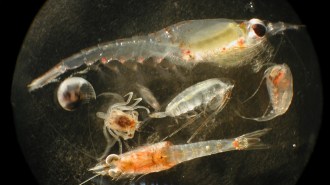- More than 2 years ago
Mirror, mirror, on the wall, what’s the most hazardous pesticide form of all? Such is the question that scientists and regulators should be asking as they evaluate the environmental effects of pesticides, new research suggests.
Many molecules, like gloves of a pair, exist in mirror-image forms. A team of environmental researchers has found that for some insecticides, one mirror-image variant, or enantiomer, is more toxic or degrades more slowly in the environment than its counterpart does. Since pesticides typically are mixtures of both enantiomers of a pair, understanding the differences between the two could lead to more-effective and less environmentally hazardous agrochemicals.
Although different enantiomers of the same molecule are identical chemically and physically, they can have dramatically different biological activities. “As a result, they interact differently with microbes in the soil or aquatic organisms,” according to Wayne Garrison of the Environmental Protection Agency’s National Exposure Research Laboratory in Athens, Ga.
Approximately 25 percent of all pesticides have an asymmetrical structure that can give rise to enantiomers. That proportion will increase as pesticide chemists develop more-complex chemical structures, says Jianying Gan of the University of California, Riverside.
As they report in the Jan. 18 Proceedings of the National Academy of Sciences, Gan and his colleagues isolated the enantiomers of several commonly used insecticides and evaluated each for toxicity and degradation in the environment.
The researchers exposed two species of water fleas to varying concentrations of each enantiomer and determined the concentration at which 50 percent of the organisms died.
Not only did the experiment reveal differences in toxicity between the enantiomers of each pair, but in some cases the difference was large. For instance, for insecticides known as synthetic pyrethroids, the toxicity of one enantiomer proved to be 17 to 38 times that of the other.
“One was doing all the damage, while the other was totally inactive,” says Gan.
His team also analyzed sediments from a site—near a tree nursery—that was contaminated with the same insecticides that the researchers were studying. Gan and his colleagues determined the rates at which enantiomers had degraded there. They found that each of the more-toxic enantiomers had broken down more slowly than its less-toxic chemical partner did.
Earlier studies also looked at handedness, or chirality, when examining the environmental fate of pesticides but focused on older chemicals, such as DDT, that are now banned, says Garrison. Also, these studies didn’t examine the enantiomers’ toxicities.
The new study is important, Garrison says, because it offers some of the first publicly available data on both the toxicity and environmental fate of chiral pesticides that are widely used today. The new findings could help governments regulate pesticides more effectively by taking into account both the toxicity and persistence of each enantiomer, says Gan.







